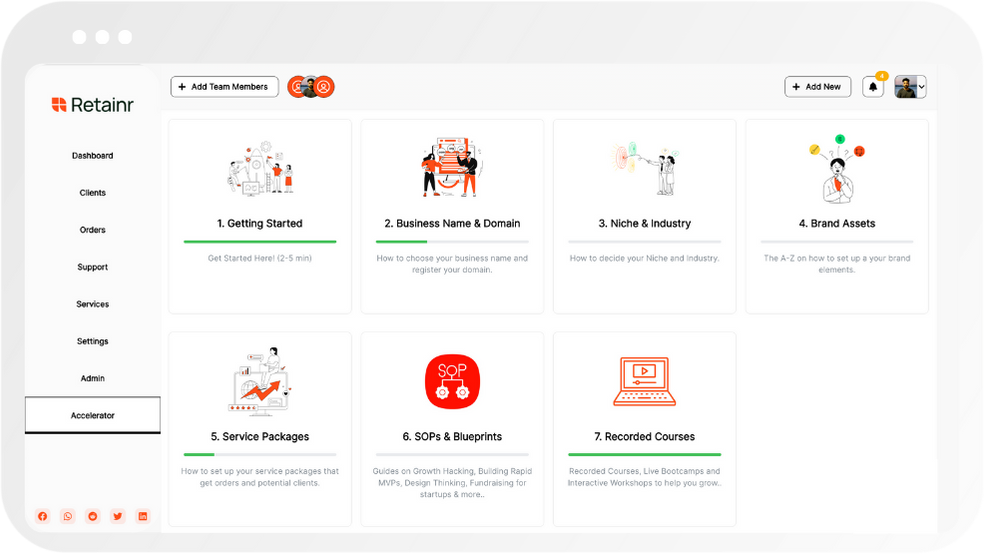
How Workflow Automation can Maximize Efficiency
Build with Retainr
Sell your products and services, manage clients, orders, payments, automate your client onboarding and management with your own branded web application.
Get Started1. What is workflow automation and how can it maximize efficiency?
Understanding Workflow Automation
Workflow automation is a designed series of automated actions for the steps in a business process. It is utilized to enhance the organization's workflow by directing tasks, resources, and operational procedures to their designated sections, optimizing the routine course of action. Workflow automation solutions simplify regular, time-consuming activities, freeing up staff to focus on high-level functions that require human intervention.
Maximizing Efficiency through Workflow Automation
Workflow automation can maximize efficiency in several ways. Firstly, it eliminates manual tasks, which not only saves time but also reduces the potential for human errors. This leads to a more accurate, swift, and efficient work process. Secondly, it enhances communication and collaboration by ensuring that everyone in the process knows their roles and the tasks they need to complete. Lastly, automating workflows leads to transparency and better tracking of work progress. This enables managers to identify bottlenecks or other issues in the work process more effectively.
Examples of Efficiency through Workflow Automation
| Automation Process | Benefits |
|---|---|
| Automated Email Responses | Saves time by automatically responding to standard inquiries. |
| Scheduling Tools | Prevents scheduling conflicts and allows better time management. |
| Automated Report Generation | Reduces time spent on creating regular reports, resulting in more time for data analysis. |
By automating these tasks, businesses can focus their resources on strategic initiatives while significantly reducing their operating costs.
2. How does workflow automation reduce manual tasks?
Reducing Manual Tasks through Workflow Automation
Workflow automation is the process of identifying, automating, and streamlining tasks that consume an immense amount of time, thereby reducing manual intervention. If properly implemented, automating daily business operations can significantly condense the time required to execute tasks, thus maximizing efficiency.
Here are some of the ways workflow automation can minimize the necessity for manual tasks:
- Improving Task Assignment: Automated workflows allow you to allocate tasks to employees based on pre-defined rules without human interference. This eradicates the need for manual assignment and tracking, offering a systematic approach to ensure tasks are completed within the stipulated timeframe.
- Eliminating Paper Work: Workflow automation can digitize all the paperwork, saving ample time that gets wasted sorting, filing, and retrieving documents manually. It aids in maintaining electronic records which are easily accessible and retrievable.
- Reducing Human Error: By diminishing the need for manual data entry, it significantly reduces the chances of errors that can have significant consequences.
- Speeding Up Decision Making: Automated workflows enable quick and informed decision making as the required data is readily available. This saves employees from wasting time hunting for information manually.
Let’s look at a simplified depiction of how automation can trim the manual tasks:
| Manual Task | Automated Task |
|---|---|
| Manual data entry | Data entry through OCR |
| Manual task allocation | Task allocation through pre-defined rules |
| Document filing and organization manually | Digital document management |
| Decision making based on scattered data | Decision making based on readily available data |
3. What are the significant benefits of workflow automation in improving business efficiency?
Significant Benefits of Workflow Automation
Workflow automation provides myriad benefits to businesses in terms of improved efficiency. Ultimately, the aim is to use automation to streamline processes, reduce manual labour and errors, and greatly enhance productivity. Here are some of the critical benefits:
- Improved Accuracy: Manual data input inevitably introduces a risk of errors. Workflow automation reduces this risk and significantly improves the accuracy of data.
- Paperless Workflow: Not only does this save environmental resources, but it also reduces clutter, preventing important documents from being misplaced.
- Faster Turnaround Times: Automated workflows allow for faster completion of business processes by eliminating manual time-consuming tasks.
Direct Impact on Business Efficiency
The direct impact on business efficiency through workflow automation is undeniable. Efficiency gains are seen in various aspects of day-to-day operations, such as productivity, responsiveness, and costs.
| Aspect | Impact |
|---|---|
| Productivity | Improvement in employee productivity as repetitive tasks are automated. |
| Responsiveness | Quicker response times to client enquiries due to automated notifications and escalations. |
| Cost | Savings through reduction in manual work and human resources allocation. |
Operational Efficiency and Workflow Automation
Operational efficiency is remarkably improved by implementing workflow automation. With tasks being performed in a systematic, predefined manner, time-consumption is controlled, processes are streamlined, and overall business efficiency is improved. Here are some other aspects in which operational efficiency is maximized:
- Error Minimization: Fewer human errors occur as tasks become automated.
- Process Transparency: Provides visibility of the entire process, promoting accountability and making it easier to identify bottlenecks.
- Better Use of Resources: Automation free up valuable resources, helping to reduce costs and improve the overall effectiveness of your business operations.
4. How does workflow automation streamline communication and decision-making processes?
Streamlining Communication with Workflow Automation
The use of workflow automation results in streamlined communication in numerous ways. Firstly, automated notifications inform team members when their participation is crucial in a particular task, thereby ensuring all pertinent parties are in the take. Secondly, centralized communication platforms are often incorporated, reducing the time spent searching through emails or chat histories for specific details. Lastly, updation of progress becomes automated, providing everyone with a real-time, clear view of the task at hand.
- Automated Notifications
- Centralized Communication Platforms
- Up-to-the-minute progress updates
The Impact of Workflow Automation on Decision-Making
Workflow automation can significantly enhance the decision-making process for businesses. The automated systems aid in centralizing data from various sources, reducing the hours spent coordinating data from different departments. It also fosters efficient task tracking, ensuring that managers are comprehensively aware of the workload and performance levels, empowering them to make informed choices. Not to mention, the transparent execution means data-driven performance analysis becomes feasible and helps in making strategic decisions. Here's a table for better illustration:
| Data Centralization | Task Tracking | Performance Analysis |
|---|---|---|
| Aggregates data from diverse sources into a single platform | Monitors workload and performance in real time | Provides insights that guide strategic decision making |
The Combined Advantage
Having both communication and decision-making processes streamlined by workflow automation results in elevated overall efficiency. Processes become smoother with the system taking over the daunting administrative tasks. Employee engagement and productivity soars as employees can focus on their core competencies instead of coordination and data management. Businesses are empowered to make quicker, more informed decisions that can significantly bolster their performance, and drive their competitive advantage.
5. How can workflow automation save time and resources in a business?
Benefits of Workflow Automation
Workflow automation is a crucial function in today's fast-paced business environment. In essence, this technology eliminates manual, repetitive tasks and replaces them with smart and auomated processes that lead to business efficiency and productivity in the workplace. First and foremost, it saves time by automating repetitive tasks and reducing the need for physical intervention, thereby giving employees more freedom to focus on their core tasks. Secondly, it aids in the conservation of resources by becoming more efficient, eliminating redundant processes, and reducing wasted efforts.
Time Saving
- Faster decision-making: Workflow automation ensures quick decision-making by routing information to the right people at the right time. This eliminates delays and accelerates the execution of tasks.
- Elimination of manual tasks: Manual and mundane tasks consume valuable time. Automation dispenses with these tasks and allows employees to devote their time to more critical tasks.
- 24/7 operations: The beauty of automation is that it can function round the clock, thereby ensuring that business operations continue efficiently even outside business hours.
Resource Saving
Measurable savings in resources can come from workflow automation. Below is a brief quantification of possible savings :
| Resource | Gains from Automation |
|---|---|
| Manpower | Reduces the need for extrastaff as automation can perform multiple tasks. |
| Costs | Reduces operational costs as automation can eliminate errors leading to financial loss. |
| Material | Fewer resources go to waste as automation ensures accuracy and precision. |
6. Can workflow automation lead to error reduction and increased reliability, thereby maximizing efficiency?
Workflow Automation and Error Reduction
Workflow automation can significantly lead to error reduction and increase overall reliability in different operational processes. The human factor in tasks often leaves room for errors and inconsistency. Automated systems, however, assume these roles and perform the tasks based on pre-set rules and algorithms, reducing the possibility of errors.
- Reduced manual data entry: With automated systems, the requirement to enter data manually is eliminated, thus reducing the probability of input errors.
- Consistent rule application: These systems apply the same set of rules in every instance, ensuring consistency, which significantly reduces errors.
- Improved data accuracy: These systems can validate information or identify and fix errors instantly, leading to higher data accuracy.
Increased Reliability Through Workflow Automation
Increased reliability is another crucial benefit that workflow automation brings. It does not suffer from fatigue, distractions, or forgetfulness, hence delivering reliable and consistent results. Automated systems also offer real-time tracking and transparency, which contributes to operation reliability.
| Automated task scheduling: | Ensures that tasks are carried out at the right time, without delays, enhancing reliability. |
| 24/7 operations: | An automated system can operate non-stop, which is impossible for manual operations, thus increasing reliability. |
| Reduced risk of loss: | As tasks are performed accurately and timely, it minimizes potential losses due to errors or delays. |
Maximizing Efficiency Through Workflow Automation
By effectively reducing errors and increasing reliability, workflow automation directly contributes to maximizing efficiency. Automated systems can process tasks faster and more accurately than manual processes. They can also handle a higher volume of tasks without requiring more resources. As a result, more work can be accomplished in less time, resources are better utilized, and the productivity level increases, thus maximising the overall operational efficiency.
7. In what ways can companies track progress and analyze performance through workflow automation?
Tracking Progress
Workflow automation provides several ways to track progress in a company. These include:
- Real-time Monitoring: This allows companies to keep an eye on tasks as they are being executed. It enables detection of any delays or bottlenecks, which can then be addressed immediately.
- Task Status Reports: Automated systems can generate detailed statistics about task performance including completion times and any encountered problems.
- Audit Trails: Workflow automation keeps a record of all actions taken in regard to a task. This allows for easy tracing of work progress and identification of process gaps.
Analyzing Performance
Not only does workflow automation enable tracking of progress, but it also facilitates performance analysis. Here's how:
- Data Analysis: Automated systems can gather and analyze large amounts of data, offering useful insights into performance metrics such as productivity levels and process efficiency.
- Benchmarking: Companies can set performance targets and compare actual outcomes against these benchmarks, thus identifying areas that need improvement.
- Feedback Mechanisms: Workflow automation provides feedback mechanisms, allowing for continuous improvement in procedures and processes based on performance results.
Workflow Automation in Action
To provide a concrete example, consider a company that processes invoices. The table below describes how workflow automation can track progress and analyze performance in this context:
| Measure | Workflow Automation Application |
|---|---|
| Real-time Monitoring | Tracks each invoice as it moves through the approval process, highlighting any delays. |
| Task Status Reports | Generates statistics on how long it takes to process each invoice, and how often errors occur. |
| Data Analysis | Analyzes data on invoice processing times and error rates to identify trends, patterns and areas for improvement. |
| Benchmarking | Compares actual processing times and error rates against set goals to measure efficiency and effectiveness. |
8. How does workflow automation foster collaboration and teamwork to enhance efficiency?
Workflow Automation Encourages Collaboration
Workflow automation streamlines and standardizes various tasks and processes in a business setting. This, in turn, encourages collaboration among the staff. Firstly, it helps eliminate silos by ensuring that everyone has access to the same information at every stage of the project. Each team member can update their progress, issues, and concerns in real time. Secondly, automating tasks leaves more time for team discussions and meetings, providing more opportunities for collaboration. Thirdly, it ensures accountability because every task is recorded and assigned to someone, making it easier to track progress and evaluate performance.
Enhancement of Teamwork Through Workflow Automation
- Better communication: Automation tools often come with integrated communication features including chat, video conferencing, and email, which help to facilitate better teamwork.
- Greater transparency: With every task and project detail at everyone's fingertips, there is no room for misunderstandings about task ownership or project status.
- Increased accessibility: Cloud-based workflow automation tools allow team members to access work documents remotely, thereby encouraging seamless collaboration.
- Improved feedback: Workflow automation enables teams to leave comments and feedback on each other's work, promoting constructive criticism and ultimately, improved outcomes.
Effects of Automated Workflows on Efficiency
| Aspect | Effect on Efficiency |
|---|---|
| Real-time updates | Helps with immediate decision-making and swift issue resolution. |
| Reduced manual errors | Automation significantly reduces the likelihood of errors, enhancing the overall quality and speed of work. |
| Task scheduling | Automated scheduling keeps all team members informed about their tasks, deadlines, and ensures no tasks are forgotten or overlooked, hence increasing productivity. |
| Enhanced collaboration | Improved communication and transparency lead to better team collaboration and ultimately, higher efficiency. |
9. Can workflow automation improve customer service and in what ways does it contribute to efficiency?
Improvement of Customer Service through Workflow Automation
Workflow automation can drastically improve customer service, leading to stellar customer experiences and enhanced customer loyalty. Automated workflows ensure that your customer service team is more focused, efficient and capable of providing prompt responses. This happens in several ways:
- Reduced response time: By automating your customer service processes, you can ensure that responses to customer queries are systematically and rapidly made.
- Streamlining customer requests: Workflow automation ensures that customer queries and demands are streamlined, making it easier for your team to manage and deliver personalized solutions.
- Error minimization: Automated systems are less prone to errors compared to manual systems, ensuring more accurate responses to customer issues and queries.
Workflow Automation's Contribution to Efficiency
Workflow automation is a vital tool that boosts efficiency in a myriad of ways. For instance, automation eliminates the need for manual tasks, which often consume a lot of time and resources. With automation, tasks are executed without requiring employees to physically perform them. Below is a table summarizing the ways in which workflow automation contributes to efficiency:
| Benefits of Workflow Automation | Description |
|---|---|
| Time-Saving | Automated systems perform tasks faster and reduce monotonous work. |
| Decreases Operational Costs | By eliminating manual tasks, operational cost is significantly reduced. |
| Increase in Productivity | Employees concentrate on more critical tasks, which yields a much higher level of productivity in the end. |
In Conclusion
Undoubtedly, workflow automation can improve customer service and increase efficiency. By reducing response times and errors, streamlining customer requests, and allowing more availability for critical tasks, organizations can thrive with improved customer satisfaction and operational efficiency. Embracing workflow automation isn’t just a wise move – it’s essential in today’s fast-paced world.
10. Is investing in workflow automation a cost-effective strategy for enhancing business efficiency?
Cost-Effectiveness of Workflow Automation for Business Efficiency
Investing in workflow automation is recognized as a cost-effective strategy for boosting business efficiency. The initial cost may appear significant; however, the long-term benefits and savings it provides, ensure an excellent return on investment. Several reasons substantiate this argument.
- Reduced labor costs: Workflow automation can manage tasks that previously required manual intervention, diminishing labor costs.
- Time-saving: Automated workflows perform operations much faster than human employees. This speed results in more tasks accomplished within the same period leading to increased productivity.
- Error minimization: Human errors are significantly reduced, if not entirely eliminated, with automated workflows, thereby saving costs associated with fixing these mistakes.
- Better resource allocation: With manual tasks automated, businesses can focus human resources on more strategic and revenue-generating activities.
The precise cost-benefit ratio can vary widely from one organization to another. Aspects like the size of the company, the industry, the nature of tasks to be automated, and the chosen automation solution affect the return on investment. The table below provides a simplified example of a possible cost and returns scenario from adopting workflow automation.
| Item | Cost | Return |
|---|---|---|
| Workflow Automation Software | $5000 | Saves 100 hours monthly, avoiding human error |
| Training Staff | $2000 | More skilled staff that can focus on core business tasks |
| Maintenance | $500 annually | Continued productivity and efficiency |
| Total | $7500 | Significant savings over time |
Conclusion
Maximizing Efficiency through Workflow Automation
Workflow automation is a game-changer when it comes to efficiency in businesses. It streamlines repetitive tasks, reducing the risk of human error, and freeing up teams to focus on more strategic tasks. Not only does it save time, but it also increases productivity and improves customer service. The potential advantages are limitless, but, to enjoy all these benefits, companies need a reliable partner. That's where Retainr.io comes in.
Increase Your Efficiency with Retainr.io
Welcome to the world of Retainr.io, a whitelabel software designed to help businesses maximize their efficiency. With Retainr.io, you can sell, manage clients, orders and payments all from your own branded app.
This comprehensive software uplifts businesses by automating repetitive tasks, therefore improving accuracy and efficiency. With less time spent on administrative tasks, your team is liberated to focus on areas that drive growth and provide better customer service.
Why Retainr.io?
Retainr.io prioritizes user-friendly interface and smooth processes. Our software is designed for everyone - whether you're tech-savvy or not. It offers a seamless integration, ensuring a quick set-up and low learning curve for your team.
By choosing Retainr.io, you're automating processes, improving accuracy, saving time and ultimately, boosting your business success. Ready to maximize your efficiency with Retainr.io? Visit www.retainr.io to get started.
Boost Your Agency Growth
with Retainr Accelerator
Uncover secrets, strategies, and exclusive blueprints to take your agency's growth to the next level — from marketing insights to effective presentations and leveraging technology.

SOPs, Cheatsheets & Blueprints
Leverage 50+ SOPs (valued over $10K) offering practical guides, scripts, tools, hacks, templates, and cheat sheets to fast-track your startup's growth.
Connect with fellow entrepreneurs, share experiences, and get expert insights within our exclusive Facebook community.
.jpg)

Join a thriving community of growth hackers. Network, collaborate, and learn from like-minded entrepreneurs on a lifelong journey to success.

Gain expertise with recorded Courses, Live Bootcamps and interactive Workshops on topics like growth hacking, copywriting, no-code funnel building, performance marketing and more, taught by seasoned coaches & industry experts.

.jpg)

.jpeg)


